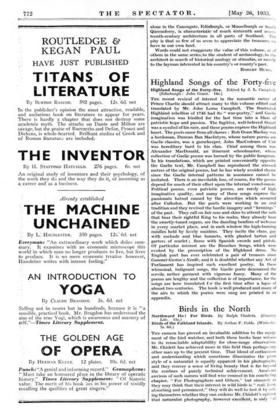Antiquities of Fife
Antiquities of Fife. The Report of the. Royal Commission on Ancient Monuments of Scotland for Fife, Kinross and Clack- mannan. (H.M. Stationery Office, Edinburgh. £1 17s. 6d.)
- _
Many of us, for instance, are familiar with Inchcolm, St. Andrews and Dunfermline, perhaps fewer with Falkland ; but the aerial view of St. Andrews in this volume gives one a far better grasp of the proper relation of the existing fragments of the Cathedral to each other than it is possible to get on the site, while the careful documentation and illustration of Inchcolm Abbey and Falkland Palace provide one with a pretty adequate basis for further study. Popular inaccuracies such as the very early date generally given to the cell in Iriblicolni, are corrected, and the possible reasons for previous misunderstanding explained ; an interesting and proper function for a dispassionate account of this kind to perform.
Deserving of particular study and strangely neglected by students is the series of small towers and lairds' houses in this district—Earlshall, Scotstarvit, probably built round about 1600 by the author of The Staggering State of Scots Statesmen, Tullibole, Aldie, Pitcullo, Balgonie, Rosyth, Alloa and Collairnie—all worth knowing. .Scotstarvit, which seems to share with Alloa. the reputation of being the least altered structurally, lies a few miles south of Cupar, the-county town of Fife, and is unoccpuied. All these late mediaeval and seven- teenth-century buildings have a simple but bold massing in general effect which is most refreshing to, the eye and com: pletely unlike English architecture. Like some modern buildings they look as though they had grown organically rather than by the ordinary stone-by-stone process of building.
Another group worthy of notice is the series of seventeenth- century Town Houses or Tolbooths. The municipal architec- ture of Culross, Dysart, West Wemyss, Clackmannan, Crail, &e., is particularly striking on account of the designs of the towers in each case. Several instances are given in this volume, also, of church towers in the same neighbourhood having points of similarity, usually in the roof-designs, to the Tolbooths. Indeed, the various forms taken • by the slate roofs of Scottish Tolbooth and Church towers of this date, and the sources of inspiration (probably Flemish) for the many entertaining examples that survive, would make a good research subject, for the extreme freedom and vigour of design shown even in the area covered by this volume, let FIFE and the neighbouring counties of Kinross and Clack- mannan are not well known in, and still less known outside of
Scotland, for from early times this district has tended towards an exclusiveness and individuality which still survives. Apart from one or two well-known buildings therefore, much in this book will strike the reader as unfamiliar and refreshing, though
even in the case of better-known places it is surprising how many new aspects an Inventory of this kind, copiously illus- trated, will bring forth. alone in the Canongate, Edinburgh. or Mnsselburgh or South Queensferry, is characteristic of much 'sixteenth and seven- teenth-century architecture in all parts of Scotland. The pity is that so -few of us seem to appreciate the treasures we have in our own land.
Words could not exaggerate the value of this volume, or of others in the same series, to the student of archaeology, to the architect in search of historical analogy or stimulus, or merely to the layman interested in his country's or county's past.
' ROBERT HURL.

















































 Previous page
Previous page